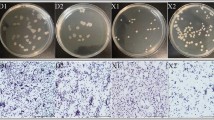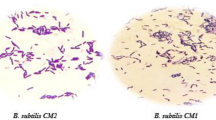Abstract
Siderophoregenic Bacillus strain DET9 has been selectively isolated from dairy waste. It was evaluated for probiotic characteristics and susceptibility pattern against antibiotics. Its spores showed excellent tolerance to simulated gastrointestinal tract conditions and exhibited antimicrobial activity against organisms such as Escherichia coli, Micrococcus flavus, and Staphylococcus aureus. Its susceptibility to antibiotics reduces the prospect to donate resistance determinants if administered in the form of probiotic preparations. It was observed to produce ∼60 mg/l catecholate type of siderophore under iron stressed conditions, identified as a 2,3-dihydroxy benzoic acid by high-performance liquid chromatography, infrared spectroscopy, nuclear magnetic resonance, and mass spectral analysis. Partial 16S-rRNA gene sequencing analysis shows that the isolate exhibited homology with Bacillus thuringiensis and Bacillus weihenstephanensis, whereas biochemical characterization revealed its novelty. DET9 exhibited no mortality of fishes in a 60-day trial, when fishes (surfi tetra) were challenged up to 100 ppm cell concentration, with their daily diet.



Similar content being viewed by others

References
Rowland, I. (1999). Probiotics and benefits to human health: The evidence in favour. Environmental Microbiology, 1, 375–382. doi:10.1046/j.1462-2920.1999.00064.x.
Shanahan, F. (2004). Probiotics in inflammatory bowel disease: Therapeutic rationale and role. Advanced Drug Delivery Reviews, 56, 809–818. doi:10.1016/j.addr.2003.11.003.
Czerucka, D., & Rampal, P. (2002). Experimental effects of Saccharomyces boulardii on diarrheal pathogens. Microbes and Infection, 4, 733–739. doi:10.1016/S1286-4579(02)01592-7.
Patterson, J. A., & Burkholder, K. M. (2003). Application of prebiotics and probiotics in poultry production. Poultry Science, 82, 627–631.
Sanders, M. E., Morelli, L., & Tompkins, T. A. (2003). Sporeformers as human probiotics: Bacillus, Sporolactobacillus, and Brevibacillus. Comprehensive Revies in Food Science and Food Safety, 2, 101–110. doi:10.1111/j.1541-4337.2003.tb00017.x.
Pinchuk, I. V., Bressollier, P., Verneuil, B., Fenet, B., Sorokulova, I. B., Megraud, F., et al. (2001). In vitro anti-Helicobacter pylori activity of the probiotic strain Bacillus subtilis 3 is due to secretion of antibiotics. Antimicrobial Agents and Chemotherapy, 45, 3156–3161. doi:10.1128/AAC.45.11.3156-3161-2001.
D’Arienzo, R., Maurano, F., Mazzarella, G., Luongo, D., Stefanile, R., Ricca, E., et al. (2006). Bacillus subtilis spores reduce susceptibility to Citrobacter rodentium-mediated enteropathy in a mouse model. Research in Microbiology, 157, 891–897. doi:10.1016/j.resmic.2006.06.001.
Tejada-Simon, M. V., Ustunol, Z., & Pestka, J. J. (1999). Effects of lactic acid 849 bacteria ingestion on basal cytokine mRNA and immunoglobulin levels 850 in the mouse. Journal of Food Protection, 62, 287–291.
Lee, J. Y., Janes, B. K., Passalacqua, K. D., Pfleger, B. F., Bergman, N. H., Liu, H., et al. (2007). Biosynthetic analysis of the petrobactin siderophore pathway from Bacillus anthracis. Journal of Bacteriology, 189, 1698–1710.
May, J. J., Wendrich, T. M., & Marahiel, M. A. (2001). The dhb operon of Bacillus subtilis encodes the biosynthetic template for the catecholic siderophore 2,3-dihydroxybenzoate-glycine-threonine trimeric ester bacillibactin. The Journal of Biological Chemistry, 276(10), 7209–7217. doi:10.1074/jbc.M009140200.
Lankford, C. E. (1973). Bacterial assimilation of iron. Critical Reviews in Microbiology, 2, 273–331. doi:10.3109/10408417309108388.
Suryalala, D., Umamaheswardevi, P. & Vijayalakshmi, K. (2004). Chemical characterization and in vitro antibiosis of siderophore of rhizosphere fluorescent Pseudomonas. Ind. J. Microbiol, 105–108.
Chincholkar, S. B., Chaudhari, B. L., & Rane, M. R. (2007). Microbial siderophores in human and plant health care. In A. Varma, & S. B. Chincholkar (Eds.), Soil Biology: Microbil siderophore (pp. 205–214). Berlin: Springer.
Koransky, J. R., Allen, S. D., & Dowell, V. R. J. (1978). Use of ethanol for selective isolation of spore-forming microorganisms. Applied and Environmental Microbiology, 35, 762–765.
Muller, G., & Raymond, K. (1984). Specificity and mechanism of ferrioxamine mediated iron transport in Streptomyces pilosus. Journal of Bacteriology, 160(1), 304–312.
Pidiyar, V., Kaznowski, A., Narayan, N. B., Patole, M., & Shouche, Y. S. (2002). Aeromonas culicicola sp. nov., from the midgut of Culex quinquefasciatus. International Journal of Systematic and Evolutionary Microbiology, 52(5), 1723–1728. doi:10.1099/ijs.0.02019-0.
Duc, L. H., Hong, H. A., Barbosa, T. M., Henriques, A. O., & Cutting, S. M. (2004). Characterisation of Bacillus probiotics available for human use. Applied and Environmental Microbiology, 70, 2161–2171. doi:10.1128/AEM.70.4.2161-2171.2004.
Pugsley, A. P. (1985). Escherichia coli K12 strains for use in the identification and characterization of colicins. Journal of General Microbiology, 131, 369–376.
Thapa, N., Pal, J., Pal, J., & Tamang, J. P. (2004). Microbial Diversity in Ngari, Hentak and Tungtap, Fermented Fish Products of North-East India. World Journal of Microbiology & Biotechnology, 20, 599–607. doi:10.1023/B:WIBI.0000043171.91027.7e.
Jonsson, H., Strom, F., & Roos, S. (2001). Addition of mucin to the growth medium triggers mucus-binding activity in different strains of Lactobacillus reuteri in vitro. FEMS Microbiology Letters, 204, 19–22. doi:10.1111/j.1574-6968.2001.tb10855.x.
Roos, S., Karner, F., Axelsson, L., & Jonsson, H. (2000). Lactobacillus mucosae sp. nov., a new species with in vitro mucus-binding activity isolated from pig intestine. International Journal of Systematic and Evolutionary Microbiology, 50, 251–258.
Del Re, B., Sgorbati, B., Miglioli, M., & Palenzona, D. (2000). Adhesion, autoaggregation and hydrophobicity of 13 strains of Bifidobacterium longum. Letters in Applied Microbiology, 31, 438–442. doi:10.1046/j.1365-2672.2000.00845.x.
Kos, B., Suskovic, J., Vokavic, S., Simpraga, M., Frece, J., & Matosic, S. (2003). Adhesion and autoaggregation ability of probiotic strain Lactobacillus acidophilus M92. j. Applied Microbiology, 94, 981–987. doi:10.1046/j.1365-2672.2003.01915.x.
Schwyn, B., & Neilands, J. B. (1987). Universal chemical assay for the detection and determination of siderophores. Analytical Biochemistry, 160, 47–56. doi:10.1016/0003-2697(87)90612-9.
Arnow, L. E. (1937). Colorimetric determination of the components of 3, 4-Dihydroxyphenyl alanine- tyrosine mixtures. The Journal of Biological Chemistry, 118, 531–537.
Csaky, T. Z. (1948). On the estimation of bound hydroxylamine in biological materials. Acta Chemica Scandinavica, 2, 450–454. doi:10.3891/acta.chem.scand.02–0450.
Payne, S. M. (1994). Detection, isolation and characterization of siderophores. Methods in Enzymology, 235, 329–344. doi:10.1016/0076-6879(94)35151-1.
Aneja, K. R. (2003). Experiments in microbiology plant pathology and Biotechnology (4th ed.). Daryaganj, New Delhi: New age international publishers.
Claus, D., & Berkeley, R. C. W. (1986). Genus Bacillus Cohn 1872. In P. H. A. Sneath (Ed.), Bergey’s Manual of Systematic Bacteriology, Section 13, Vol.2 (pp. 1105–1139). Baltimore, MD, USA: Williams & Wilkins.
Rhodehamel, J., & Harmon, S. M. (2001). Bacteriological Analytical Manual (8th Ed), 1998. US Food and Drug Administration. Chapter 14. US FDA-CFSAN BAM-Bacillus cereus.htm
Pandey, A., Bringel, F., & Meyer, J. M. (1994). Iron requirement and search for siderophores in lactic acid bacteria. Appl. Microbial and Cell Physiol, 40(5), 735–739.
Bezkorovainy et al., (1989). Biochemistry and Physiology of Bifidobacteria (pp. 147–176). In A. Bezkorovainy & R. Miller-Catchpole (Eds.). CRC.
Ueda, S. (1989). In B. Maruo, & H. Yoshikawa (Eds.), Utilization of soybean as natto: a traditional Japanese food, Bacillus subtilis: molecular biology and industrial application pp. 143–161. Amsterdam, The Netherlands: Elsevier.
Crueger, W., & Crueger, A. (1982). Enzymes. In W. Crueger, & A. Crueger (Eds.), Biotechnology: a textbook of industrial microbiology pp. 161–174. Madison, Wis. USA: Science Tech.
Casula, G., & Cutting, S. M. (2002). Bacillus probiotics: spore germination in the gastrointestinal tract. Applied and Environmental Microbiology, 68, 2344–2352. doi:10.1128/AEM.68.5.2344-2352.2002.
Nakano, M. M., & Zuber, P. (1998). Anaerobic growth of a “strict aerobe” (Bacillus subtilis). Annual Review of Microbiology, 52, 165–190. doi:10.1146/annurev.micro.52.1.165.
Sanders, M. E., Morelli, L., & Tompkins, T. A. (2003). Comprehensive Reviews in Food Science and Food Safty, Sporeformers as Human Probiotics: Bacillus, Sporolactobacillus, and Brevibacillus, 2, 101–110. www.ift.org/publications/crfsfs.
SCAN. (2001). Report of the Scientific Committee on Animal Nutrition on product Toyocerin_ for use as feed additive. European Commission, Health and Consumer Protection Directorate-General. (SCAN) Scientific Committee on Animal Nutrition. Available from: http://europa.eu.int/comm/food/fs/sc/scan/out72_en.pdf.
SCAN. (2000). Report of the Scientific Committee on Animal Nutrition on product BioPlus 2B_ for use as feed additive. European Commission, Health and Consumer Protection Directorate-General. (SCAN) Scientific Committee on Animal Nutrition. Available from: http://europa.eu.int/comm/food/fs/sc/scan/out49_en.pdf.
Bellon-Fontaine, M. N., Rault, J., & van Oss, C. J. (1996). Microbial adhesion to solvents: a novel method to determine the electrondonor/ electron-acceptor or Lewis acid-base properties of microbial cells. Colloids and Surfaces, 7, 47–53. doi:10.1016/0927-7765(96)01272-6.
Pedersen, K., & Tannock, G. W. (1989). Colonization of the porcine gastrointestinal tract by lactobacilli. Applied and Environmental Microbiology, 55, 279–283.
Freter, M. (1992). Factors affecting the microecology of the gut. In R. Fuller (Ed.), Probiotics. The Scientific Basis pp. 111–145. Glasgow: Chapman & Hall.
Alander, M., Korpela, R., Saxelin, M., Vilpponen-Salmela, T., Matilla-Sandholm, T., & Wright, A. (1997). Recovery of Lactobacillus rhamnosus GG from human colonic biopsies. Letters in Applied Microbiology, 24, 361–364. doi:10.1046/j.1472-765X.1997.00140.x.
Otero, M. C., Ocana, V. S., & Macias, E. N. M. (2004). Bacterial surface characteristics applied to selection of probiotic microorganisms. Methods in Molecular Biology (Clifton, N.J.), 268, 435–440.
Rijnaarts, H. H. M., Norde, W., Bouwer, E. J., Lyklema, J., & Zehnder, A. J. B. (1993). Bacterial adhesion under static and dynamic conditions. Applied and Environmental Microbiology, 59, 3255–3265.
Pannucci, J., Okinaka, R. T., Sabin, R., & Kuske, C. R. (2002). Bacillus anthracis pXO1 Plasmid Sequence Conservation among Closely Related Bacterial Species. Journal of Bacteriology, 184(1), 134–141. doi:10.1128/JB.184.1.134-141.2002.
Yilmaz, M., Soran, H., & Beyatli, Y. (2006). Antimicrobial activities of some Bacillus spp. strains isolated from the soil. Microbiological Research, 161(2), 127–131. doi:10.1016/j.micres.2005.07.001.
Lee, K. H., Jun, K. D., Kim, W. S., & Paik, H. D. (2001). Partial characterization of polyfermenticin SCD, a newly identified bacteriocin of Bacillus polyfermenticus. Letters in Applied Microbiology, 32, 146–151. doi:10.1046/j.1472-765x.2001.00876.x.
Hyronimus, B., Le Marrec, C., & Urdaci, M. C. (1998). Coagulin, a bacteriocin-like inhibitory substance produced by Bacillus coagulans 14. Journal of Applied Microbiology, 85, 42–50. doi:10.1046/j.1365–2672.1998.00466.x.
Chincholkar, S. B., Chaudhari, B. L., Talegaonkar, S. K., & Kothari, R. M. (2000). “Microbial iron chelators: A sustainable tool for the biocontrol of plant disease”. In R. K Upadhyay, K. G. Mukerji, & P. C. Chamola (Eds.), Biocontrol potential and its exploitation in sustainable agriculture (vol. Vol. 1, pp. 49–70). USA: Kluwer Academic/Plenum.
Sharma, A., & Johri, B. N. (2003a). Combat of iron-deprivation through a plant growth promoting fluorescent Pseudomonas strain GRP3A in mung bean (Vigna radiata L. Wilzeck). Microbiological Research, 158, 77–81. doi:10.1078/0944-5013-00182.
Poole, K., & McKay, G. A. (2003). Iron acquisition and its control in Pseudomonas aeruginosa: Many roads lead to Roam. Frontiers in Bioscience, 8, 661–686. doi:10.2741/1051.
Acknowledgement
Financial support (grant no. BT/PR-7587/PID/20/300/2006) by DBT, Government of India, Ministry of Science and Technology, New Delhi is highly acknowledged.
Author information
Authors and Affiliations
Corresponding author
Rights and permissions
About this article
Cite this article
Patel, A.K., Ahire, J.J., Pawar, S.P. et al. Evaluation of Probiotic Characteristics of Siderophoregenic Bacillus spp. Isolated from Dairy Waste. Appl Biochem Biotechnol 160, 140–155 (2010). https://doi.org/10.1007/s12010-009-8583-2
Received:
Accepted:
Published:
Issue Date:
DOI: https://doi.org/10.1007/s12010-009-8583-2



